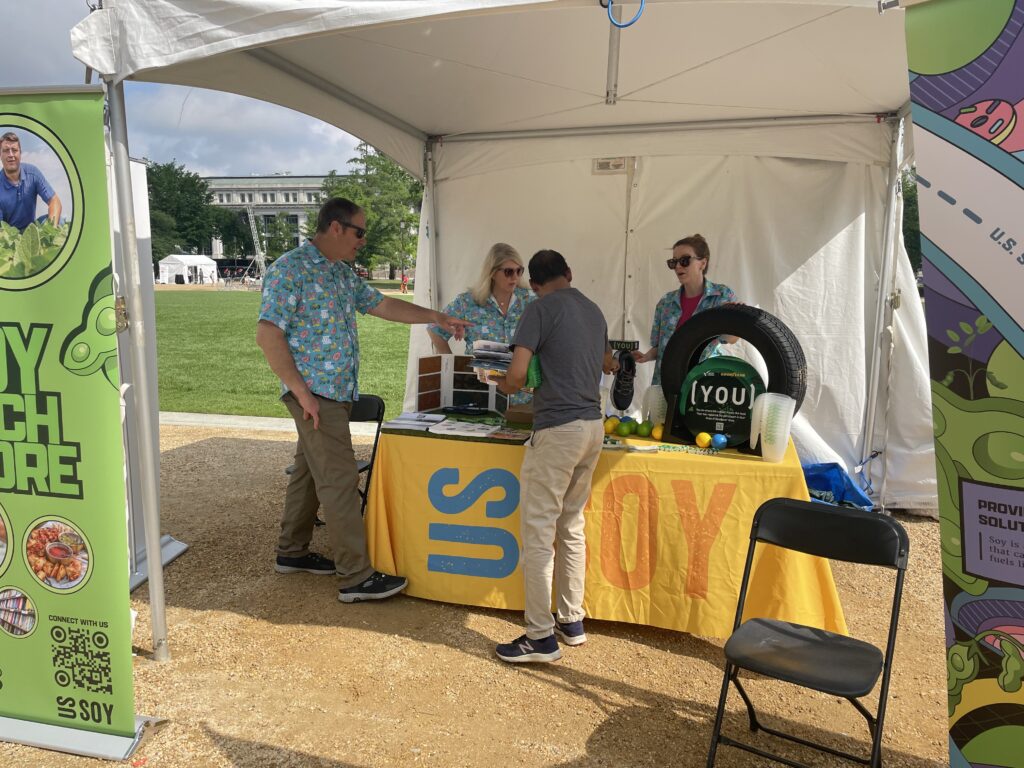The Ground Work series shares the perspectives of U.S. soybean farmers as they observe how the U.S. Soy industry lays the groundwork to grow innovative, reliable and sustainable solutions for people and communities around the world.
What do sandals, tires, cooking oil, shrimp, fire-fighting foam, plywood and jet fuel have in common?
They all can be made more sustainably with U.S. Soy.
I got to surprise countless people with facts about how soybeans are “Soy Much More” than edamame during Ag on the Mall, an event on the National Mall in Washington, D.C., in early May.
Farmers and agribusinesses from across agriculture joined together in the heart of Washington, D.C., to showcase the Future of Food and Farming during the second celebration of modern agriculture on the National Mall, which is surrounded by the U.S. Capitol, the White House, monuments, museums and government administrative buildings. The event allowed us to tell our stories to everyone from politicians and government staff to tourists and families on vacation.
The event highlights the economic development, technological and sustainability advances and exports that come from farmers like me in rural America.
I farm with my wife, my daughters and my brother, near Bucyrus, Ohio, about 430 miles or more than 690 kilometers northwest of Washington, D.C. Our farm is roughly halfway between the southern shore of Lake Erie and Columbus, Ohio. We raise soybeans, as well as corn, malting barley, hay and wheat.
Because we had a very rainy spring, we had barely started planting our crops by the first full week of May. Our fields were too wet to plant, so I took advantage of the opportunity to explain how soybeans provide unexpected sustainable solutions for every life, every day
Most people really don’t know very much about soybeans. So, the U.S. Soy team explained how soybeans get crushed to separate oil from the protein meal. From there, each part of a soybean can become a renewable input or ingredient for food, feed, fuel, fiber and more.
In food, soybeans do make tofu and edamame. However, soybean oil is commonly labeled vegetable oil, an ingredient used in baking, frying and cooking. I highlighted how we developed a type of soybeans that produce high oleic soybean oil, which has no trans fats and a nutritional profile similar to olive oil. Other soy ingredients from the protein portion of the beans are used in many foods, as well.
As a component of feed, soybean meal provides a source of protein and nutrients for animals of all kinds, including pets, pigs, chicken, cows, fish and shrimp.
Soybean oil can replace petroleum-based oil in many industrial uses, but the most common is in fuel tanks. As interest in low-carbon fuel grows, soybean oil has become an important feedstock for options like biodiesel, renewable diesel and sustainable aviation fuel.
In fact, in many areas including Ohio, soybean crushing plants are expanding to better supply this growing industry. With demand for soybean oil growing for fuel, more soybean meal will be available.
There are many fascinating ways soy can be used. And that’s where I got “wow” responses from people I talked with on the Mall.
- Cross Plains Solutions recently introduced SoyFoam, a firefighting foam suppressant made from U.S. soy flour.
- Soy-based ingredients remove formaldehyde in the glue used to make plywood.
- Okabashi, a U.S.-based shoe company, uses soy-based components in sandals and flip flops.
- Goodyear Tire Company makes tires that incorporate U.S. Soy.
- Soy is used in the dust suppressant applied to the gravel paths of the National Mall during this event to keep the air cleaner.
Soy connects with so much of life, and I enjoyed sharing that with many people. One family from the Washington, D.C., metro area came to visit some monuments. They had never been to the countryside, so I got to introduce them to the ways soy touches them every day.
At the same time, I talked about how soybeans are renewable. I grow them every year, and they help sequester carbon both in soils and in the plants.
Can you identify a sustainable soy solution that showed up in your life today?



